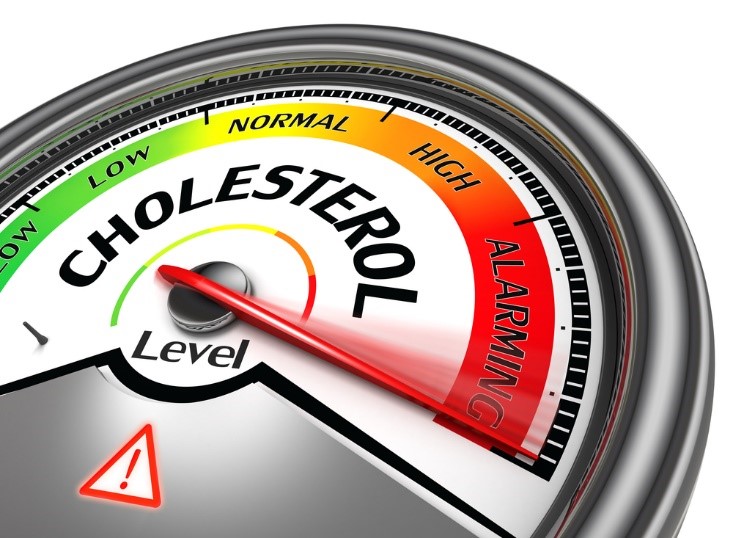High Cholesterol: Symptoms, Causes & Range
- 5 Jan, 2024
- Written by Team Dr Lal PathLabs
Medically Approved by Dr. Seema
Table of Contents

Cholesterol refers to the fat-like substance found in the body’s cells. Body produces cholesterol in the liver and also obtains it through animal-based foods such as meat, eggs, and dairy products. It is essential to note that these dietary sources have less impact on blood cholesterol levels than the saturated and trans fats consumed.
Cholesterol is a natural cell membrane component and essential for various bodily functions. While it is often associated with health risks, it is necessary to know that the body must maintain a certain cholesterol level to function properly.
What are the types of cholesterol?
Cholesterol travels through the bloodstream and is attached to proteins in packages called lipoproteins. There are two main types of cholesterol:
- Low-Density Lipoprotein (LDL): Bad cholesterol or LDL cholesterol is a build-up on the walls of arteries that forms plaques that can narrow and block blood flow. This can increase the risk of heart disease and stroke.
- High-Density Lipoprotein (HDL): Known as good cholesterol, HDL cholesterol helps remove LDL cholesterol from the bloodstream, transporting it to the liver for disposal. Higher levels of HDL are associated with a lower risk of heart disease.
What are the functions of cholesterol?
Cholesterol plays some vital roles in the body, including:
- Cell Membrane Structure: Cholesterol is essential to cell membranes, helping maintain fluidity and stability.
- Hormone Production: Cholesterol helps create various hormones, including estrogen, testosterone, cortisol, and aldosterone.
- Bile Acid Production: Cholesterol produces bile acids in the liver, which are necessary to digest dietary fats.
What are the causes of high cholesterol?
Below are some of the main causes of high cholesterol:
- Unhealthy Diet: Consuming excessive saturated and trans fats is a leading cause of harmful cholesterol levels.
- Obesity: A person with a body mass index over 30 is prone to high cholesterol.
- Physical Inactivity: Lack of regular exercise can lower levels of HDL, the good cholesterol.
- Smoking: Smoking can decrease HDL cholesterol levels.
- Alcohol: Excessive alcohol consumption can raise LDL cholesterol levels.
- Genetics: Genetic makeup can make it more challenging for the body to get rid of LDL cholesterol from blood or metabolise it in the liver.
- Medical Conditions: Certain health conditions, including chronic kidney disease, diabetes, HIV/AIDS, hypothyroidism, and lupus, can contribute to unhealthy cholesterol levels.
- Medications: Certain medicines prescribed for conditions such as acne, cancer, high blood pressure, HIV/AIDS, and organ transplants can worsen cholesterol levels.
What are the risk factors associated with high cholesterol?
Here are some health risks associated with high cholesterol:
- Atherosclerosis: Cholesterol buildup in the arteries can lead to atherosclerosis, restricting blood flow.
- Heart Disease: High cholesterol increases the risk of heart disease, including heart attacks and angina.
- Stroke: Cholesterol plaque can lead to blood clot formation, potentially causing a stroke.
- Peripheral Artery Disease: Reducing blood flow to the limbs can lead to pain and complications.
- Hypertension: High cholesterol can contribute to high blood pressure, which strains the cardiovascular system.
What are high-cholesterol symptoms?
It is challenging to diagnose high cholesterol as it seldom shows any symptoms. It is best to get a cholesterol test done by a doctor, as it only appears in lipid panel tests. High cholesterol levels often go unnoticed and can lead to stroke.
Here are some signs that may indicate a high cholesterol level:
- Angina (Chest Pain): High cholesterol can contribute to the development of coronary artery disease, which may result in chest pain or discomfort known as angina. Decreased blood flow to the heart because of plaque buildup in the arteries causes angina.
- Xanthomas: These fatty deposits can form on the skin, particularly around the eyes, tendons, and hands. Xanthomas are often a result of high cholesterol levels.
- Arcus Senilis: This is a white or greyish ring that appears around the cornea’s edge (the eye’s transparent front part). It can indicate high cholesterol levels, especially in younger people.
- Frequent Fatigue: Elevated cholesterol levels can lead to the development of atherosclerosis, which can reduce blood flow to various organs, including the muscles. This reduced blood flow may result in fatigue or weakness.
- Plaque Build-up in Arteries: The formation of plaques in arteries can lead to atherosclerosis, which may eventually cause symptoms like leg cramping during physical activity (claudication).
What is the normal cholesterol range?
Below is the cholesterol normal range in mg/dL for a healthy heart:
| Age | Total Cholesterol | Non-HDL Cholesterol | HDL Cholesterol | LDL Cholesterol |
| Under 19 | Below 170 | Below 120 | Below 110 | Above 45 |
| Males above 20 | 125-200 | Below 130 | Below 100 | 40 or above |
| Females above 20 | 125-200 | Below 130 | Below 100 | 50 or above |
What is the diagnosis of high cholesterol?
Understanding the balance and proper regulation of cholesterol levels is critical for maintaining good overall health. High cholesterol is diagnosed through a lipid profile blood test. It measures total cholesterol, triglycerides, and LDL and HDL cholesterol levels in the bloodstream. Doctors also review the patient’s family history, considering any genetic influences related to high cholesterol or cardiovascular diseases. Regular screenings and thorough evaluations are critical in maintaining heart health and preventing potential complications.













